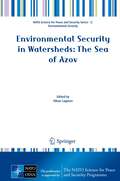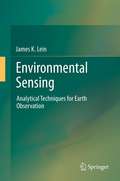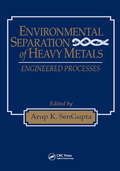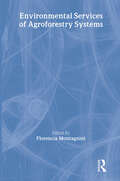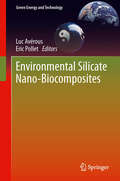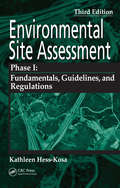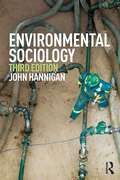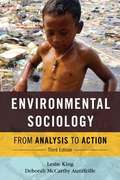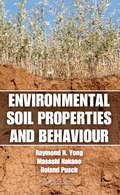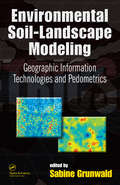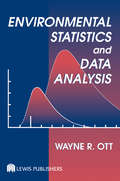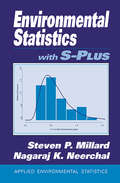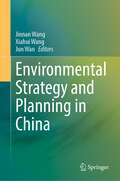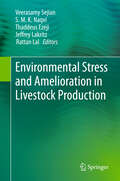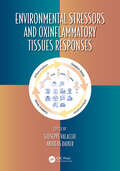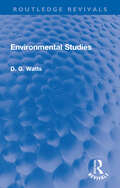- Table View
- List View
Environmental Security in Watersheds: The Sea of Azov
by Viktor LagutovWatersheds, supplying crucial ecosystem services to humans, seem to be a logical territorial unit to integrate societal benefits and environmental needs in order to evaluate the sustainability of natural resource use patterns. Based on this belief the book is an attempt to initiate a comprehensive environmental security assessment in the basin of the Azov Sea, shared by Russia and Ukraine. Though the region provides a variety of essential services and plays a strategic role in national and international development plans, it has been excluded from most regional environmental discussions. At the same time there is an alarming degradation rate of basin freshwater ecosystems that has occurred due to overutilization of certain prioritized services (e.g. transportation). The collapse of neglected services (e.g. fishery and freshwater supply) poses serious threats to the national economies as well as the local population, and to mitigate these threats priority in water management should be given to securing sustainability of the regional freshwater ecosystems. In addition to the review of the current status of Azov ecosystem services, the authors analyze likely future availability and challenges. The relevant experience derived from basin management of the Black Sea and other similar basins is also discussed.
Environmental Security in the Arctic Ocean
by Paul Arthur Berkman Alexander N. VylegzhaninThis seminal book results from a NATO Advanced Research Workshop at the University of Cambridge with Russian co-directorship, enabling the first formal dialogue between NATO and Russia about security issues in the Arctic Ocean. Involving interdisciplinary participation with experts from 17 nations, including all of the Arctic states, this workshop itself reflects progress in Arctic cooperation and collaboration. Interests now are awakening globally to take advantage of extensive energy, shipping, fishing and tourism opportunities in the Arctic Ocean as it is being transformed from a permanent sea-ice cap to a seasonally ice-free sea. This environmental state-change is introducing inherent risks of political, economic and cultural instabilities that are centralized among the Arctic states and indigenous peoples with repercussions globally. Responding with urgency, environmental security is presented as an "integrated approach for assessing and responding to the risks as well as the opportunities generated by an environmental state-change." In this book - diverse perspectives on environmental security in the Arctic Ocean are shared in chapters from high-level diplomats, parliamentarians and government officials of Arctic and non-Arctic states; leaders of Arctic indigenous peoples organizations; international law advisors from Arctic states as well as the United Nations; directors of inter-governmental organizations and non-governmental organizations; managers of multi-national corporations; political scientists, historians and economists; along with Earth system scientists and oceanographers. Building on the "common arctic issues" of "sustainable development and environmental protection" established by the Arctic Council - environmental security offers an holistic approach to assess opportunities and risks as well as develop infrastructure responses with law of the sea as the key "international legal framework" to "promote the peaceful uses" of the Arctic Ocean. With vision for future generations, environmental security is a path to balance national interests and common interests in the Arctic Ocean for the lasting benefit of all.
Environmental Security of the European Cross-Border Energy Supply Infrastructure
by V. I. Osipov M. G. Culshaw S. J. Booth A. S. VictorovThe current volume provides examples of how environmental hazards such as landslides, earthquakes, mountain processes, cold climate processes and tidal flows and currents can affect the energy supply infrastructure. In times of uncertainty, the security of the European cross-border energy supply infrastructure, such as pipelines, has great importance. Whilst the potential effects of political disagreement, economic inequalities and social differences are relatively well understood, the impact of environmental change is often poorly appreciated by decision-makers. New approaches have been examined for monitoring of hazardous landslide processes, including early warning systems, and near-real-time 3D data processing and visualization. The scientific problems of environmental systems design have been discussed and approaches for their implementation have been suggested. New integrated remote sensing techniques consisting mainly of hyperspectral and radar imagery are presented together with the processing of monitoring data using GIS techniques and, in particular, dynamic visualization. Attention is also given to conceptual issues of environmental and energy security and the role of education, to help resolve environmental problems through cooperation in the development of the European energy supply infrastructure.
Environmental Sensing
by James K. LeinRemote sensing has witnessed a renaissance as new sensor systems, data collection capabilities and image processing methodologies have expanded the technological capabilities of this science into new and important applications areas. Perhaps nowhere has this trend been more evident than in the study of earth environments. Within this broad application area remote sensing has proven to be an invaluable asset supporting timely data gathering at a range of synoptic scales, facilitating the mapping of complex landscapes and promoting the analysis of environmental process. Yet remote sensing's contribution to the study of human/environmental interaction is scattered throughout a rich and diverse literature spanning the social and physical sciences, which frustrates access to, and the sharing of the knowledge gained through, these recent advances, and inhibits the operational use of these methods and techniques in day to day environmental practice, a recognized gap that reduces the effectiveness of environmental management programs. The objective of this book is to address this gap and provide the synthesis of method and application that is currently missing in the environmental science, re-introducing remote sensing as an important decision-support technology.
Environmental Separation of Heavy Metals: Engineering Processes
by Arup K. SenGuptaThis new book explains advanced and emerging technologies for removing heavy metals from wastestreams and contaminated sites. Separation processes of this type are critical for meeting stringent regulations of priority pollutants, especially arsenic, mercury, and lead, which the text treats in depth. After explaining the chemistry of heavy metals a
Environmental Services of Agroforestry Systems
by Florencia Montagnini Yale UniversityGet cutting-edge agroforestry research and dataDeforestation and the rampant use of fossil fuels are major contributors to increases in atmospheric carbon dioxide and are enormous influences on global warming. Agroforestry systems and tree plantations can help mitigate the resulting climate change and degradation of biodiversity and accelerating climate change. Environmental Services of Agroforestry Systems addresses these global concerns with an essential collection of presentations on biodiversity and climate change from the First World Congress in Agroforestry (Orlando, Florida, 2004). Respected experts discuss the latest research and data on how agroforestry systems can help solve environmental problems through carbon sequestration and biodiversity conservation.Years ago, agroforestry’s environmental benefits were mainly seen as being soil amelioration, erosion control, microclimate control, and the alleviation of the effects of drought in semiarid areas. Environmental Services of Agroforestry Systems goes beyond the regional considerations of years past to focus on the challenges of today’s most pressing global environmental concerns. The contributors describe the latest research and concepts in agroforestry systems, reforestation efforts, soils, vegetation, and agriculture while reviewing their economic aspects. Incentives for reforestation and agroforestry are explored in detail. Each chapter is carefully referenced and includes tables to clarify ideas and data.Environmental Services of Agroforestry Systems addresses: advantages of mixed-species plantations tropical pasture and silvo-pastoral systems tropical forest ecosystem management research on the economic feasibility of various land-use systems socio-economic considerations of coffee-growing ecosystems agroforestry systems in Costa Rica Environmental Services of Agroforestry Systems is essential reading for researchers and scientists, as well as professionals in agroforestry, forestry, soils, global change, climate change, and environmental studies, educators, and graduate and undergraduate students.
Environmental Silicate Nano-Biocomposites
by Luc Avérous Eric PolletEnvironmental Silicate Nano-Biocomposites focuses on nano-biocomposites, which are obtained by the association of silicates such as bioclays with biopolymers. By highlighting recent developments and findings, green and biodegradable nano-composites from both renewable and biodegradable polymers are explored. This includes coverage of potential markets such as packaging, agricultures, leisure and the fast food industry. The knowledge and experience of more than twenty international experts in diverse fields, from chemical and biochemical engineering to applications, is brought together in four different sections covering: Biodegradable polymers and Silicates, Clay/Polyesters Nano-biocomposites, Clay/Agropolymers Nano-biocomposites, and Applications and biodegradation of Nano-biocomposites. By exploring the relationships between the biopolymer structures, the processes, and the final properties Environmental Silicate Nano-Biocomposites explains how to design nano-materials to develop new, valuable, environmentally friendly properties and uses. The combination of fundamental and applied science makes this an ideal reference for a range of readers from students and lecturers to material and polymer scientists and even industrial engineers who are interested in bringing new environmental nano-materials to the current market.
Environmental Site Assessment Phase I: A Basic Guide, Third Edition
by Kathleen Hess-KosaExtensively updated, this third edition provides a valuable guide to the tools and techniques used to perform Phase 1 site assessment. This book elucidates the systematic processes and methods used by leaders in the industry. It also emphasizes the development of an easy-to-follow investigative strategy for in-house assessment. After reviewing the history of the field, legal issues, and important terms, the book discusses physical setting, historic usage, property and area reconnaissance, building materials, and industrial activities associated with a property. It also gives interviewing tips, lists regulatory agencies, and considers unique situations such as wetlands and historical buildings.
Environmental Sociology
by Harald Heinrichs Matthias GroßDespite being a relatively young sub-discipline, European environmental sociology has changed considerably in the last decades towards more interdisciplinary collaborations and problem solving. Current trends such as global environmental modernization and processes of economic, political and socio-cultural globalization, fuelled by developments of transport, environmental flows, scientific uncertainty, and information technologies, have fostered new conceptual approaches that move beyond classical sociological mind-sets toward broader attempts to connect to other disciplines.
Environmental Sociology
by John HanniganThe third edition of John Hannigan’s classic undergraduate text has been fully updated and revised to highlight contemporary trends and controversies within global environmental sociology. Environmental Sociology offers a distinctive, balanced treatment of environmental issues, reconciling Hannigan’s much-cited model of the social construction of environmental problems and controversies with an environmental justice perspective that stresses inequality and toxic threats to local communities.
Environmental Sociology
by John HanniganJohn Hannigan’s definitive textbook offers a distinctive, balanced coverage of environmental issues, policies and action. This revised fourth edition has been expanded and fully updated to explore contemporary developments and issues within global environmental sociology. Environmental Sociology reconciles Hannigan’s widely cited model of the social construction of environmental problems and controversies, which states that incipient environmental issues must be identified, researched, promoted and persuasively argued in the form of "claims", with an environmental justice perspective that stresses inequality and threats to local communities. For example, this new edition explores the interconnections between indigenous communities and environmental activists via a study of the difficult relationship between Aboriginal people and environmentalists in Australia. The updated fourth edition also discusses new direct action protest groups, such as Extinction Rebellion, who have reframed the discourse around the "climate emergency" using apocalyptic language and imagery. Environmental Sociology also signposts exciting new directions for future research. The fourth edition re-interrogates the classical roots of environmental theory with a focus of the work of Alexander von Humboldt. Hannigan also asserts the need for environmental sociologists to turn their attention to "The Forgotten Ocean", arguing that the discipline should incorporate cutting-edge concepts such as marine justice, striated space and volumetrics. Environmental Sociology is a key text for students and researchers in environmental studies, political ecology, social geography and environmental sociology.
Environmental Sociology: From Analysis To Action
by Leslie King Deborah AuriffeilleEnvironmental Sociology encourages students to use the sociological imagination to explore a broad spectrum of issues facing the environment today. The third edition of this reader includes thirteen new pieces that examine how social dimensions, particularly power and inequality, interact with environmental issues. <p><p> The textbook opens with an updated introduction that introduces students to key concepts and provides a brief overview of environmental sociology as a field. The readings, excerpts from recently published pieces, are arranged by sociological issue and use a range of perspectives, including environmental justice, risk society, and power structure research. Topics span coal mining, food justice, climate change, and more. Each reading is chosen to be accessible and engaging to undergraduate students and is preceded by a brief introduction to provide context. <p> As the environmental challenges facing our world become ever more pressing, Environmental Sociology aims to equip students with the frameworks they need to approach these challenges from a sociological perspective.
Environmental Soil Properties and Behaviour
by Roland Pusch Masashi Nakano Raymond N. YongFrom bridges and tunnels to nuclear waste repositories, structures require that soils maintain their design engineering properties if the structures are to reach their projected life spans. The same is true for earth dams, levees, buffers, barriers for landfills, and other structures that use soils as engineered materials. Yet soil, a natural resou
Environmental Soil Remediation and Rehabilitation: Existing and Innovative Solutions (Applied Environmental Science and Engineering for a Sustainable Future)
by Eric D. van Hullebusch David Huguenot Yoan Pechaud Marie-Odile Simonnot Stéfan ColombanoThis book provides a comprehensive overview of innovative remediation techniques and strategies for soils contaminated by heavy metals or organic compounds (e.g. petroleum hydrocarbons, NAPLs and chlorinated organic compounds). It discusses various novel chemical remediation approaches (in-situ and ex-situ) used alone and in combination with physical and/or thermal treatment. Further, it addresses the recovery of NAPLs, reuse of leaching solutions, and in-situ chemical reduction and oxidation, and explores the chemical enhancement of physical NAPLs recovery from both practical and theoretical perspectives. Also presenting the state-of-the-art in waste-assisted bioremediation to improve soil quality and the remediation of petroleum hydrocarbons, the book is a valuable resource for students, researchers and R&D professionals in industry engaged in the treatment of contaminated soils.
Environmental Soil Science (Books in Soils, Plants, and the Environment)
by Kim H. TanCompletely revised and updated, incorporating almost a decade's worth of developments in this field, Environmental Soil Science, Third Edition, explores the entire reach of the subject, beginning with soil properties and reactions and moving on to their relationship to environmental properties and reactions. Keeping the organization and writing sty
Environmental Soil-Landscape Modeling: Geographic Information Technologies and Pedometrics
by Sabine GrunwaldEnvironmental Soil-Landscape Modeling: Geographic Information Technologies and Pedometrics presents the latest methodological developments in soil-landscape modeling. It analyzes many recently developed measurement tools, and explains computer-related and pedometric techniques that are invaluable in the modeling process.This volume provi
Environmental Statistics and Data Analysis
by Wayne R. OttThis easy-to-understand introduction emphasizes the areas of probability theory and statistics that are important in environmental monitoring, data analysis, research, environmental field surveys, and environmental decision making. It communicates basic statistical theory with very little abstract mathematical notation, but without omitting importa
Environmental Statistics with S-PLUS
by Steven P. Millard Nagaraj K. NeerchalA clear, comprehensive treatment of the subject, Environmental Statistics with S-PLUS surveys the vast array of statistical methods used to collect and analyze environmental data. The book explains what these methods are, how to use them, and where to find references to them. In addition, it provides insight into what to think about before you coll
Environmental Strategy and Planning in China
by Jun Wan Jinnan Wang Xiahui WangThis book covers the research fields in biodiversity conservation, the Belt and Road eco-environmental cooperation, China's five-year plan for eco-environmental protection, sustainable development goals assessment, and human health loss assessment. In the past, these achievements have played an important scientific role in supporting China's ecological and environmental protection, and produced extensive social impacts and significant environmental benefits. At the same time, the relevant research ideas and methods also show the latest progress and trend in the field of environmental strategy and planning in China in recent years, which can be used for reference by experts and scholars of other countries in the field of ecological environment.
Environmental Stress and Amelioration in Livestock Production
by Rattan Lal Thaddeus Ezeji Veerasamy Sejian S.M.K. Naqvi Jeffrey LakritzGiven the importance of livestock to the global economy, there is a substantial need for world-class reference material on the sustainable management of livestock in diverse eco-regions. With uncertain climates involving unpredictable extreme events (e.g., heat, drought, infectious disease), environmental stresses are becoming the most crucial factors affecting livestock productivity. By systematically and comprehensively addressing all aspects of environmental stresses and livestock productivity, this volume is a useful tool for understanding the various intricacies of stress physiology. With information and case studies collected and analyzed by professionals working in diversified ecological zones, this book explores the influence of the environment on livestock production across global biomes. The challenges the livestock industry faces in maintaining the delicate balance between animal welfare and production are also highlighted.
Environmental Stress and Cellular Response in Arthropods
by Andre Korsloot Cornelis A. van Gestel Nico M. van StraalenWhile the subject of environmental stress in animals is broad, the available information is fragmentary and lacks an up-to-date overview and analysis. Environmental Stress and Cellular Response in Arthropods fills these knowledge gaps. Written by three experts from the same institution, the chapters have a consistency not often found in mult
Environmental Stressors and OxInflammatory Tissues Responses (Oxidative Stress and Disease #53)
by Giuseppe Valacchi Andreas DaiberEnvironmental risk factors – noise, air pollution, chemical agents, and ultraviolet radiation – impact human health by contributing to the onset and progression of noncommunicable diseases. Accordingly, there is need for preclinical and clinical studies and comprehensive summary of major findings. This book is a state-of-the-art summary of these myriad severe life stressors. The chapters on the different pollutants focus on disease mechanisms (cardiovascular, neurological and metabolic disorders) and on oxidative stress and inflammation. The editors emphasize emerging mechanisms based on dysregulation of the circadian clock, the microbiome, epigenetic pathways, and cognitive function by environmental stressors, and introduce the exposome concept while highlighting existing research gaps. Key Features: · Links various environmental stressors to the incidence of noncommunicable diseases · Includes chapters on airborne toxins, chemical pollutants, noise, and ultraviolet radiation stressors · Contributions from an international team of leading researchers · Summarizes the impacts of stressors on disease mechanisms
Environmental Stressors in Health and Disease
by Jurgen FuchsThis volume illustrates the impact of environmental oxidants on the tissues of the eyes, lungs and skin, as well as on the immune system - highlighting common illnesses, injuries and pathologies induced by pro-oxidant environmental xenobiotics such as inflammation, immune response, signal transduction, regulation of gene expression, and carcinogenesis. It provides clinical presentations and discusses the effects of environmental oxidants on target organs.
Environmental Studies (Routledge Revivals)
by D. G. WattsFirst published in 1969, Environmental Studies aims to fill up a major gap by surveying the ground for a structural theory of environmental studies for schools and colleges of education. This is not a handbook or manual of environmental studies but an exercise in curriculum development. It begins by examining the terminology and concepts employed in discussing environmental studies. The historical development of the idea is then traced and the relationship between environment and learning analysed. The conclusions reached from these inquiries are then used as a basis for outlining the aims and organisations of environmental studies courses, and practical application of such programmes is considered. Topical and lucid, this book is a must read for anyone interested to know the basics of environmental studies and also relevant for teachers and educationists.
Environmental Studies and Climate Change (Translating Animal Science Research)
by S. K. Malhotra Sanjeev Puri R. C. Sobti Kamal JaiswalCurrently, anthropogenic activities have caused unprecedented destruction of the environment at alarming rates, leading to undesirable alterations in air, land, and water. The process of environment degradation has been accelerated by industrial processes, which result in waste as well as over-consumption of natural resources. The ecological balance has been disturbed, and resources have shrunk. All this has resulted in climate change, which has emerged as a major concern in the 21st century. Changes in the environment are driven by demand for energy, water, and food to raise the standard of living. These are also responsible for climate change, with contributions from deforestation and CO2 emissions from fossil fuels such as coal and petroleum. The present volume discusses some of the main issues regarding environmental degradation and the causes as well as the impact of climate change, which is impacting the ecosystem. The effects of various pollutants, causes of climate change with case studies on geochemistry and glaciers, etc., and measures to reduce the impact on biodiversity, health, etc. are discussed in detail in its chapters. In a nutshell, this volume discusses in detail the following issues: • Anthropogenic and natural factors in environmental degradation • Climate change history, causes, and threats to abiotic and biotic systems • Case studies on the impact of climate change and living systems • Mitigation and preparedness for the future
